Industry Life Cycle Phase Analysis: Business Cases and Applications
VerifiedAdded on 2022/10/12
|6
|1474
|83
Report
AI Summary
This report provides an analysis of the industry life cycle phases for several companies, including Samsung, Whole Foods Market Inc., Anandam Manufacturing Company, and AquaSafi Purification Systems. The analysis identifies the current stage of the life cycle for each company, such as maturity or growth, and discusses the strategic implications. For Samsung, operating in the maturity stage, the report emphasizes the need for strategies to maintain profitability amid competition. Whole Foods Market Inc., also in the maturity stage, is advised to focus on expansion. Anandam Manufacturing Company, in the growth stage, is advised to seek capital for expansion and product development. AquaSafi Purification Systems, a social enterprise, is also analyzed in the context of its growth stage, though the applicability of the life cycle model is questioned due to its non-profit nature. The report also discusses the application of the industry life cycle model to profit-making organizations and its limitations when applied to social enterprises. The report draws on various academic sources to support its analysis.
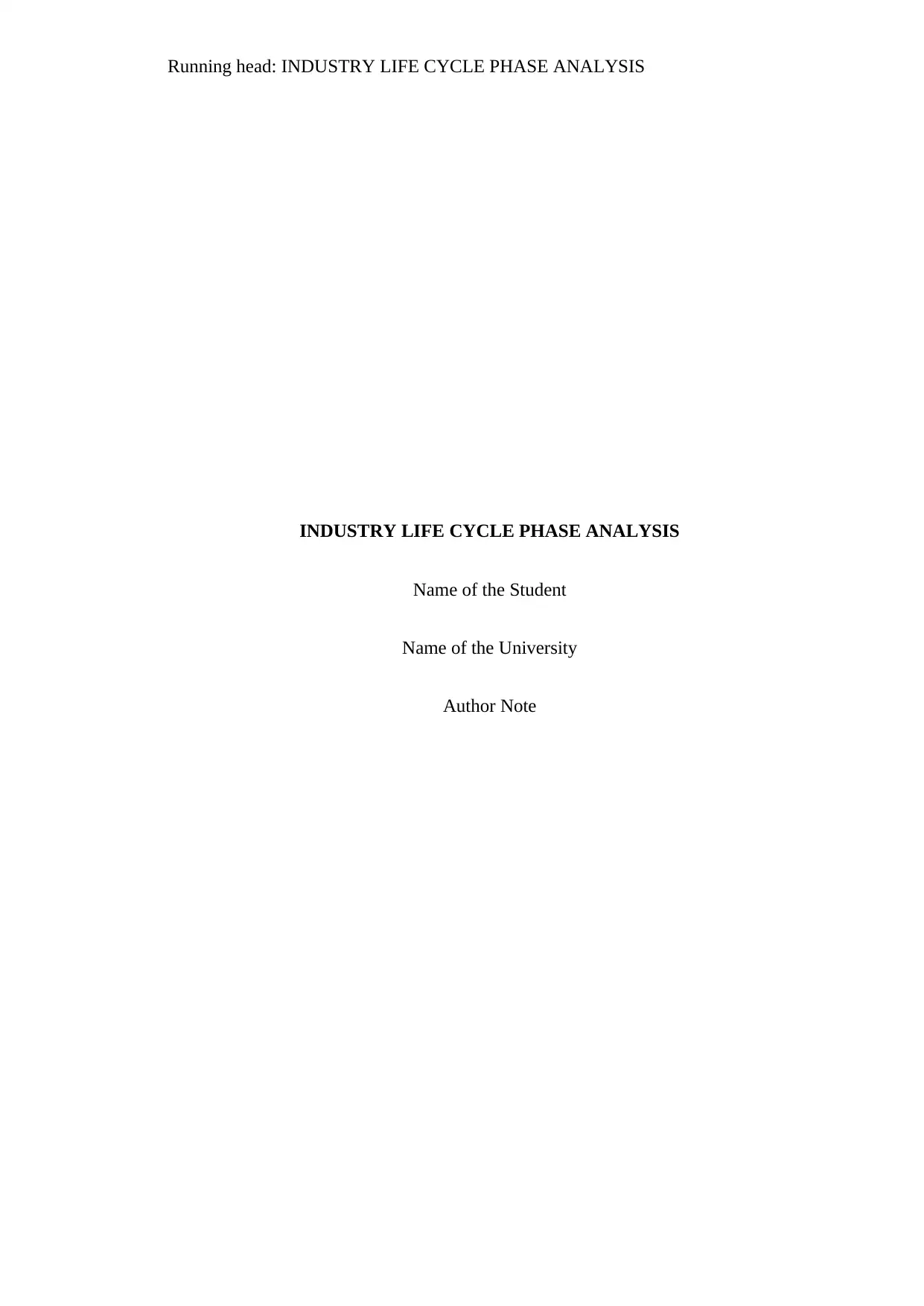
Running head: INDUSTRY LIFE CYCLE PHASE ANALYSIS
INDUSTRY LIFE CYCLE PHASE ANALYSIS
Name of the Student
Name of the University
Author Note
INDUSTRY LIFE CYCLE PHASE ANALYSIS
Name of the Student
Name of the University
Author Note
Paraphrase This Document
Need a fresh take? Get an instant paraphrase of this document with our AI Paraphraser
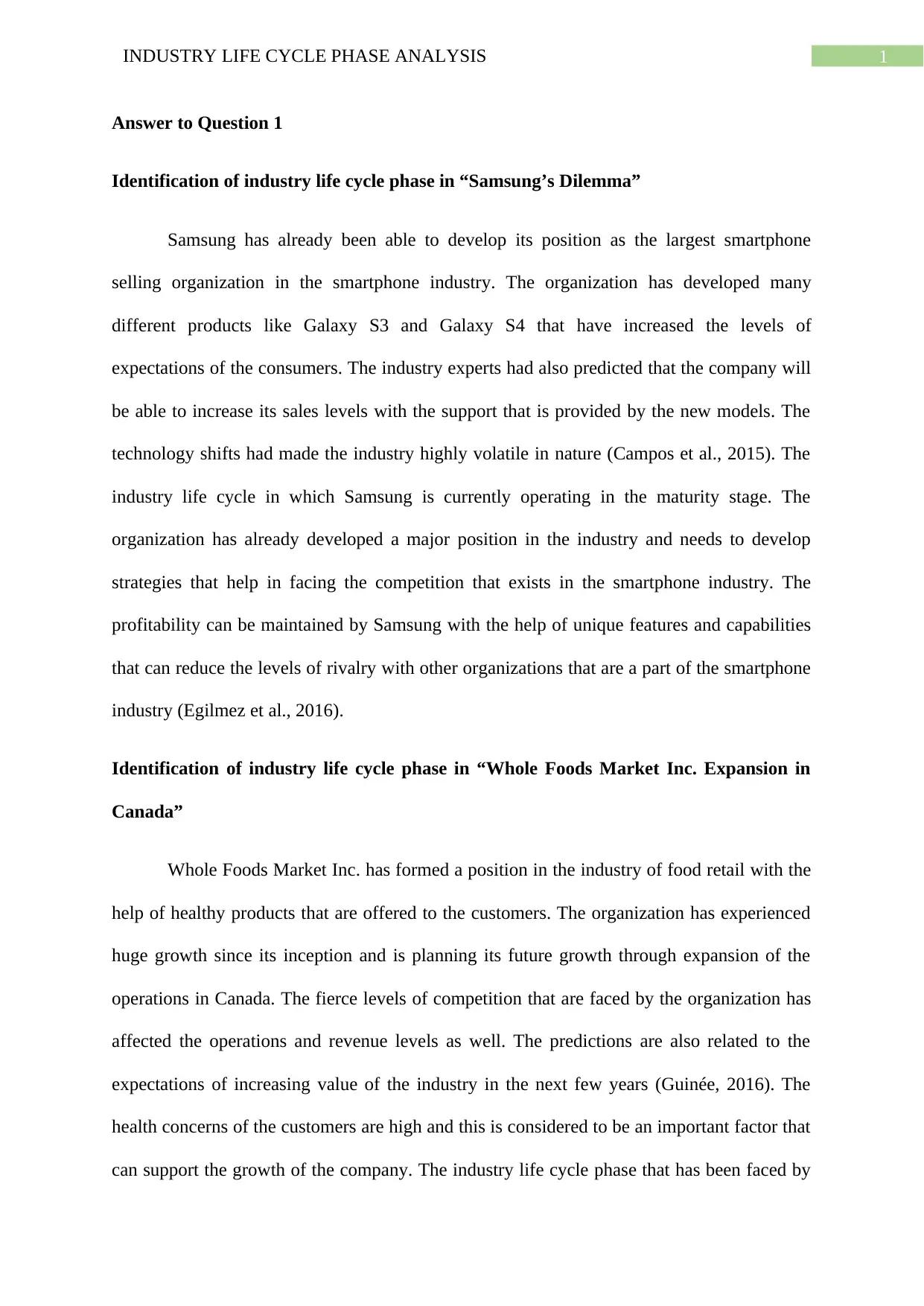
1INDUSTRY LIFE CYCLE PHASE ANALYSIS
Answer to Question 1
Identification of industry life cycle phase in “Samsung’s Dilemma”
Samsung has already been able to develop its position as the largest smartphone
selling organization in the smartphone industry. The organization has developed many
different products like Galaxy S3 and Galaxy S4 that have increased the levels of
expectations of the consumers. The industry experts had also predicted that the company will
be able to increase its sales levels with the support that is provided by the new models. The
technology shifts had made the industry highly volatile in nature (Campos et al., 2015). The
industry life cycle in which Samsung is currently operating in the maturity stage. The
organization has already developed a major position in the industry and needs to develop
strategies that help in facing the competition that exists in the smartphone industry. The
profitability can be maintained by Samsung with the help of unique features and capabilities
that can reduce the levels of rivalry with other organizations that are a part of the smartphone
industry (Egilmez et al., 2016).
Identification of industry life cycle phase in “Whole Foods Market Inc. Expansion in
Canada”
Whole Foods Market Inc. has formed a position in the industry of food retail with the
help of healthy products that are offered to the customers. The organization has experienced
huge growth since its inception and is planning its future growth through expansion of the
operations in Canada. The fierce levels of competition that are faced by the organization has
affected the operations and revenue levels as well. The predictions are also related to the
expectations of increasing value of the industry in the next few years (Guinée, 2016). The
health concerns of the customers are high and this is considered to be an important factor that
can support the growth of the company. The industry life cycle phase that has been faced by
Answer to Question 1
Identification of industry life cycle phase in “Samsung’s Dilemma”
Samsung has already been able to develop its position as the largest smartphone
selling organization in the smartphone industry. The organization has developed many
different products like Galaxy S3 and Galaxy S4 that have increased the levels of
expectations of the consumers. The industry experts had also predicted that the company will
be able to increase its sales levels with the support that is provided by the new models. The
technology shifts had made the industry highly volatile in nature (Campos et al., 2015). The
industry life cycle in which Samsung is currently operating in the maturity stage. The
organization has already developed a major position in the industry and needs to develop
strategies that help in facing the competition that exists in the smartphone industry. The
profitability can be maintained by Samsung with the help of unique features and capabilities
that can reduce the levels of rivalry with other organizations that are a part of the smartphone
industry (Egilmez et al., 2016).
Identification of industry life cycle phase in “Whole Foods Market Inc. Expansion in
Canada”
Whole Foods Market Inc. has formed a position in the industry of food retail with the
help of healthy products that are offered to the customers. The organization has experienced
huge growth since its inception and is planning its future growth through expansion of the
operations in Canada. The fierce levels of competition that are faced by the organization has
affected the operations and revenue levels as well. The predictions are also related to the
expectations of increasing value of the industry in the next few years (Guinée, 2016). The
health concerns of the customers are high and this is considered to be an important factor that
can support the growth of the company. The industry life cycle phase that has been faced by
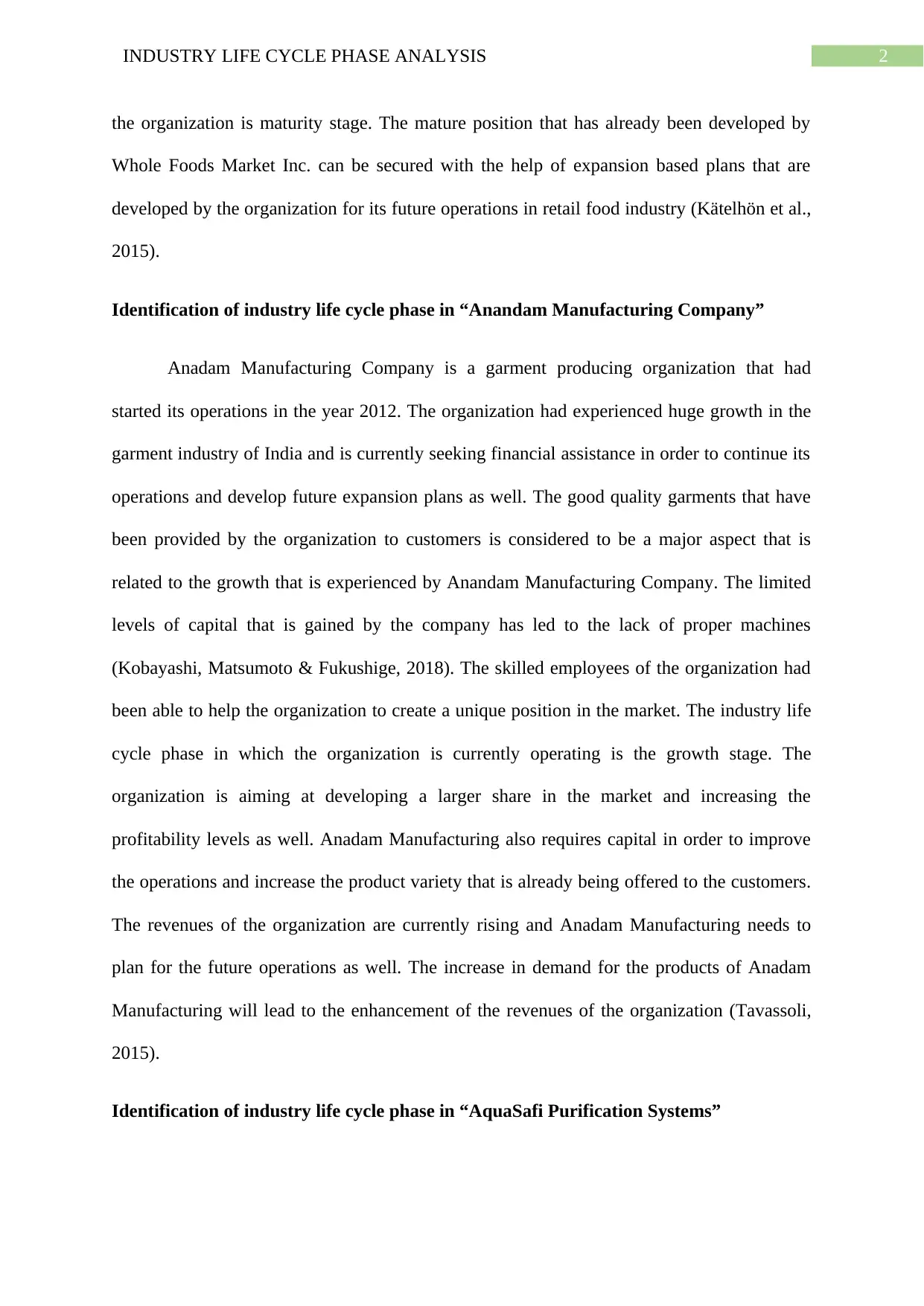
2INDUSTRY LIFE CYCLE PHASE ANALYSIS
the organization is maturity stage. The mature position that has already been developed by
Whole Foods Market Inc. can be secured with the help of expansion based plans that are
developed by the organization for its future operations in retail food industry (Kätelhön et al.,
2015).
Identification of industry life cycle phase in “Anandam Manufacturing Company”
Anadam Manufacturing Company is a garment producing organization that had
started its operations in the year 2012. The organization had experienced huge growth in the
garment industry of India and is currently seeking financial assistance in order to continue its
operations and develop future expansion plans as well. The good quality garments that have
been provided by the organization to customers is considered to be a major aspect that is
related to the growth that is experienced by Anandam Manufacturing Company. The limited
levels of capital that is gained by the company has led to the lack of proper machines
(Kobayashi, Matsumoto & Fukushige, 2018). The skilled employees of the organization had
been able to help the organization to create a unique position in the market. The industry life
cycle phase in which the organization is currently operating is the growth stage. The
organization is aiming at developing a larger share in the market and increasing the
profitability levels as well. Anadam Manufacturing also requires capital in order to improve
the operations and increase the product variety that is already being offered to the customers.
The revenues of the organization are currently rising and Anadam Manufacturing needs to
plan for the future operations as well. The increase in demand for the products of Anadam
Manufacturing will lead to the enhancement of the revenues of the organization (Tavassoli,
2015).
Identification of industry life cycle phase in “AquaSafi Purification Systems”
the organization is maturity stage. The mature position that has already been developed by
Whole Foods Market Inc. can be secured with the help of expansion based plans that are
developed by the organization for its future operations in retail food industry (Kätelhön et al.,
2015).
Identification of industry life cycle phase in “Anandam Manufacturing Company”
Anadam Manufacturing Company is a garment producing organization that had
started its operations in the year 2012. The organization had experienced huge growth in the
garment industry of India and is currently seeking financial assistance in order to continue its
operations and develop future expansion plans as well. The good quality garments that have
been provided by the organization to customers is considered to be a major aspect that is
related to the growth that is experienced by Anandam Manufacturing Company. The limited
levels of capital that is gained by the company has led to the lack of proper machines
(Kobayashi, Matsumoto & Fukushige, 2018). The skilled employees of the organization had
been able to help the organization to create a unique position in the market. The industry life
cycle phase in which the organization is currently operating is the growth stage. The
organization is aiming at developing a larger share in the market and increasing the
profitability levels as well. Anadam Manufacturing also requires capital in order to improve
the operations and increase the product variety that is already being offered to the customers.
The revenues of the organization are currently rising and Anadam Manufacturing needs to
plan for the future operations as well. The increase in demand for the products of Anadam
Manufacturing will lead to the enhancement of the revenues of the organization (Tavassoli,
2015).
Identification of industry life cycle phase in “AquaSafi Purification Systems”
⊘ This is a preview!⊘
Do you want full access?
Subscribe today to unlock all pages.

Trusted by 1+ million students worldwide
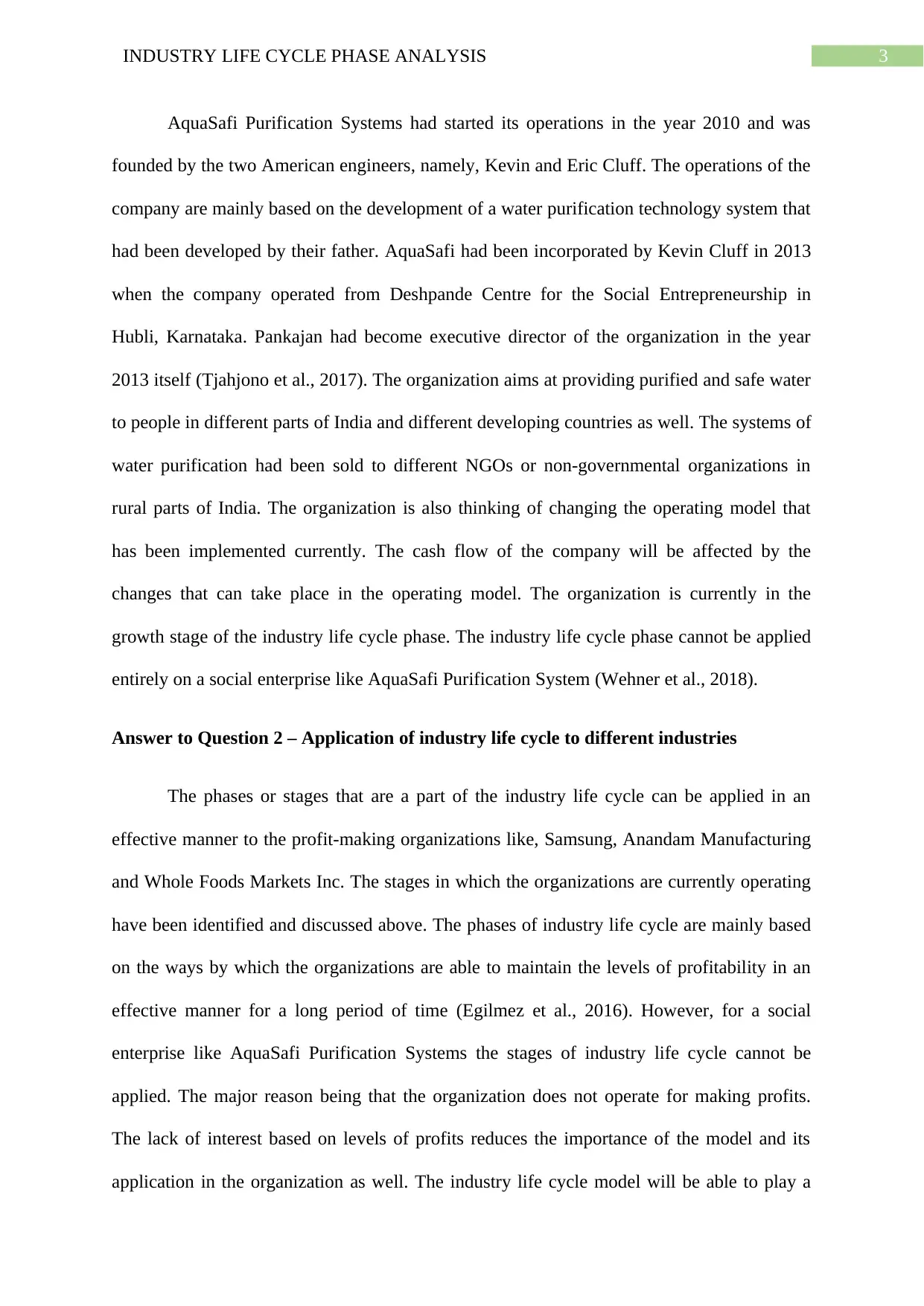
3INDUSTRY LIFE CYCLE PHASE ANALYSIS
AquaSafi Purification Systems had started its operations in the year 2010 and was
founded by the two American engineers, namely, Kevin and Eric Cluff. The operations of the
company are mainly based on the development of a water purification technology system that
had been developed by their father. AquaSafi had been incorporated by Kevin Cluff in 2013
when the company operated from Deshpande Centre for the Social Entrepreneurship in
Hubli, Karnataka. Pankajan had become executive director of the organization in the year
2013 itself (Tjahjono et al., 2017). The organization aims at providing purified and safe water
to people in different parts of India and different developing countries as well. The systems of
water purification had been sold to different NGOs or non-governmental organizations in
rural parts of India. The organization is also thinking of changing the operating model that
has been implemented currently. The cash flow of the company will be affected by the
changes that can take place in the operating model. The organization is currently in the
growth stage of the industry life cycle phase. The industry life cycle phase cannot be applied
entirely on a social enterprise like AquaSafi Purification System (Wehner et al., 2018).
Answer to Question 2 – Application of industry life cycle to different industries
The phases or stages that are a part of the industry life cycle can be applied in an
effective manner to the profit-making organizations like, Samsung, Anandam Manufacturing
and Whole Foods Markets Inc. The stages in which the organizations are currently operating
have been identified and discussed above. The phases of industry life cycle are mainly based
on the ways by which the organizations are able to maintain the levels of profitability in an
effective manner for a long period of time (Egilmez et al., 2016). However, for a social
enterprise like AquaSafi Purification Systems the stages of industry life cycle cannot be
applied. The major reason being that the organization does not operate for making profits.
The lack of interest based on levels of profits reduces the importance of the model and its
application in the organization as well. The industry life cycle model will be able to play a
AquaSafi Purification Systems had started its operations in the year 2010 and was
founded by the two American engineers, namely, Kevin and Eric Cluff. The operations of the
company are mainly based on the development of a water purification technology system that
had been developed by their father. AquaSafi had been incorporated by Kevin Cluff in 2013
when the company operated from Deshpande Centre for the Social Entrepreneurship in
Hubli, Karnataka. Pankajan had become executive director of the organization in the year
2013 itself (Tjahjono et al., 2017). The organization aims at providing purified and safe water
to people in different parts of India and different developing countries as well. The systems of
water purification had been sold to different NGOs or non-governmental organizations in
rural parts of India. The organization is also thinking of changing the operating model that
has been implemented currently. The cash flow of the company will be affected by the
changes that can take place in the operating model. The organization is currently in the
growth stage of the industry life cycle phase. The industry life cycle phase cannot be applied
entirely on a social enterprise like AquaSafi Purification System (Wehner et al., 2018).
Answer to Question 2 – Application of industry life cycle to different industries
The phases or stages that are a part of the industry life cycle can be applied in an
effective manner to the profit-making organizations like, Samsung, Anandam Manufacturing
and Whole Foods Markets Inc. The stages in which the organizations are currently operating
have been identified and discussed above. The phases of industry life cycle are mainly based
on the ways by which the organizations are able to maintain the levels of profitability in an
effective manner for a long period of time (Egilmez et al., 2016). However, for a social
enterprise like AquaSafi Purification Systems the stages of industry life cycle cannot be
applied. The major reason being that the organization does not operate for making profits.
The lack of interest based on levels of profits reduces the importance of the model and its
application in the organization as well. The industry life cycle model will be able to play a
Paraphrase This Document
Need a fresh take? Get an instant paraphrase of this document with our AI Paraphraser
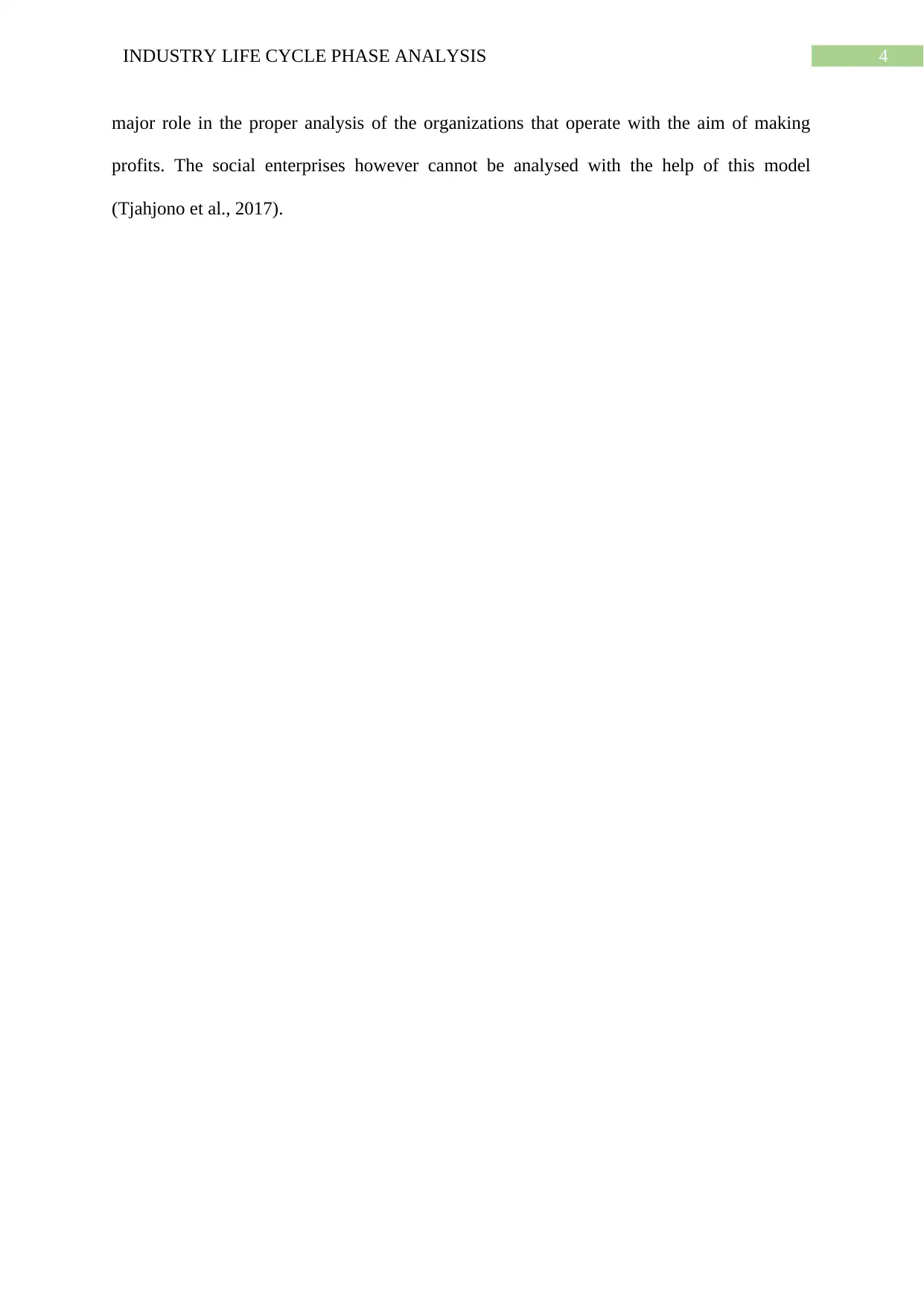
4INDUSTRY LIFE CYCLE PHASE ANALYSIS
major role in the proper analysis of the organizations that operate with the aim of making
profits. The social enterprises however cannot be analysed with the help of this model
(Tjahjono et al., 2017).
major role in the proper analysis of the organizations that operate with the aim of making
profits. The social enterprises however cannot be analysed with the help of this model
(Tjahjono et al., 2017).
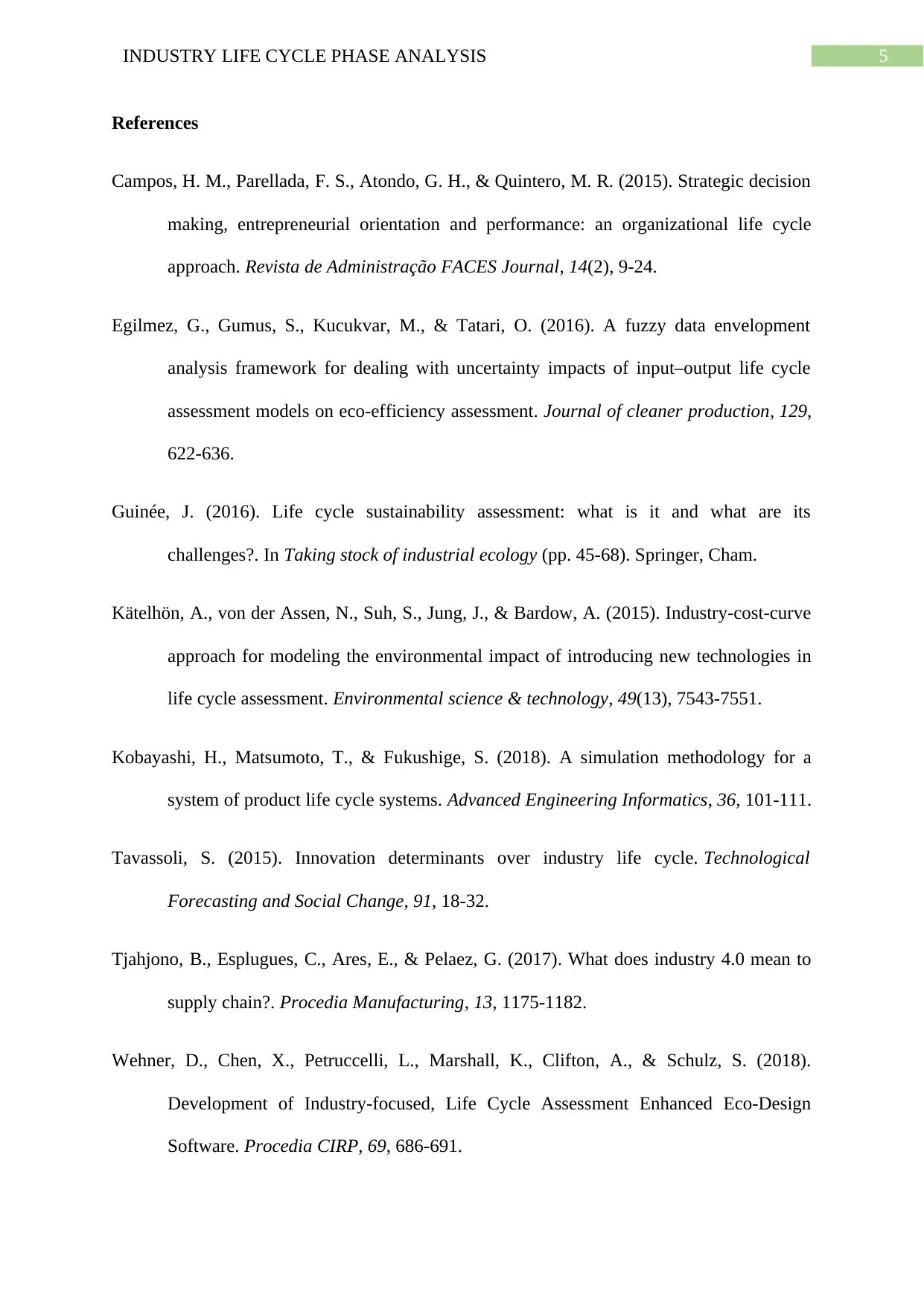
5INDUSTRY LIFE CYCLE PHASE ANALYSIS
References
Campos, H. M., Parellada, F. S., Atondo, G. H., & Quintero, M. R. (2015). Strategic decision
making, entrepreneurial orientation and performance: an organizational life cycle
approach. Revista de Administração FACES Journal, 14(2), 9-24.
Egilmez, G., Gumus, S., Kucukvar, M., & Tatari, O. (2016). A fuzzy data envelopment
analysis framework for dealing with uncertainty impacts of input–output life cycle
assessment models on eco-efficiency assessment. Journal of cleaner production, 129,
622-636.
Guinée, J. (2016). Life cycle sustainability assessment: what is it and what are its
challenges?. In Taking stock of industrial ecology (pp. 45-68). Springer, Cham.
Kätelhön, A., von der Assen, N., Suh, S., Jung, J., & Bardow, A. (2015). Industry-cost-curve
approach for modeling the environmental impact of introducing new technologies in
life cycle assessment. Environmental science & technology, 49(13), 7543-7551.
Kobayashi, H., Matsumoto, T., & Fukushige, S. (2018). A simulation methodology for a
system of product life cycle systems. Advanced Engineering Informatics, 36, 101-111.
Tavassoli, S. (2015). Innovation determinants over industry life cycle. Technological
Forecasting and Social Change, 91, 18-32.
Tjahjono, B., Esplugues, C., Ares, E., & Pelaez, G. (2017). What does industry 4.0 mean to
supply chain?. Procedia Manufacturing, 13, 1175-1182.
Wehner, D., Chen, X., Petruccelli, L., Marshall, K., Clifton, A., & Schulz, S. (2018).
Development of Industry-focused, Life Cycle Assessment Enhanced Eco-Design
Software. Procedia CIRP, 69, 686-691.
References
Campos, H. M., Parellada, F. S., Atondo, G. H., & Quintero, M. R. (2015). Strategic decision
making, entrepreneurial orientation and performance: an organizational life cycle
approach. Revista de Administração FACES Journal, 14(2), 9-24.
Egilmez, G., Gumus, S., Kucukvar, M., & Tatari, O. (2016). A fuzzy data envelopment
analysis framework for dealing with uncertainty impacts of input–output life cycle
assessment models on eco-efficiency assessment. Journal of cleaner production, 129,
622-636.
Guinée, J. (2016). Life cycle sustainability assessment: what is it and what are its
challenges?. In Taking stock of industrial ecology (pp. 45-68). Springer, Cham.
Kätelhön, A., von der Assen, N., Suh, S., Jung, J., & Bardow, A. (2015). Industry-cost-curve
approach for modeling the environmental impact of introducing new technologies in
life cycle assessment. Environmental science & technology, 49(13), 7543-7551.
Kobayashi, H., Matsumoto, T., & Fukushige, S. (2018). A simulation methodology for a
system of product life cycle systems. Advanced Engineering Informatics, 36, 101-111.
Tavassoli, S. (2015). Innovation determinants over industry life cycle. Technological
Forecasting and Social Change, 91, 18-32.
Tjahjono, B., Esplugues, C., Ares, E., & Pelaez, G. (2017). What does industry 4.0 mean to
supply chain?. Procedia Manufacturing, 13, 1175-1182.
Wehner, D., Chen, X., Petruccelli, L., Marshall, K., Clifton, A., & Schulz, S. (2018).
Development of Industry-focused, Life Cycle Assessment Enhanced Eco-Design
Software. Procedia CIRP, 69, 686-691.
⊘ This is a preview!⊘
Do you want full access?
Subscribe today to unlock all pages.

Trusted by 1+ million students worldwide
1 out of 6
Related Documents
Your All-in-One AI-Powered Toolkit for Academic Success.
+13062052269
info@desklib.com
Available 24*7 on WhatsApp / Email
![[object Object]](/_next/static/media/star-bottom.7253800d.svg)
Unlock your academic potential
Copyright © 2020–2025 A2Z Services. All Rights Reserved. Developed and managed by ZUCOL.




